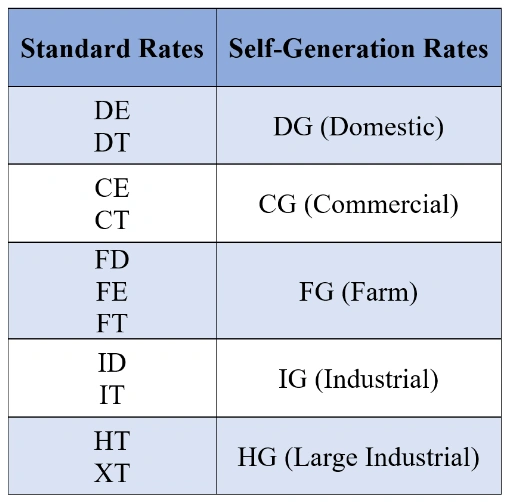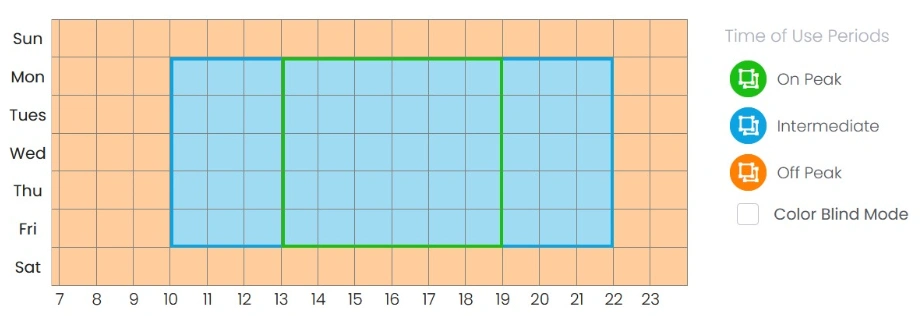November 2023 Utility Rates Newsletter
by Sarah Wood on Dec 01, 2023
utility rates
utility rates newsletter
utility rate updates
IMPORTANT MONTHLY UPDATES & ANNOUNCEMENTS
This month, we cover a 22% base rate increase for New York State Electric & Gas, highlight a name change for East Bay Community Energy in California, explain pre- and post-solar rates for Turlock Irrigation District, and discuss overlapping TOU periods and how to work with them in ETB.
NYSEG Base Rate Increases
The New York State Public Service Commission approved a 22.1% increase for NYSEG’s base rates over an 18-month period as part of an investment in improving grid reliability. The first update is this month, followed by an update in May 2024 and May 2025. The typical residential customer should expect a 10% increase in their electric bill this month, and commercial customers can expect similar increases. For example, the popular general and large service rates SC2 and SC7 increased in customer charges and demand charges. Customers on rate schedule SC 2 can expect to pay a flat $8 more every month in customer charges and an additional $1.66 per kW of demand. Customers on rate schedule SC 7 (secondary voltage) will pay an extra $54 per month in customer charges and an additional $1.44 per kW of demand.
Despite these increases to the base delivery rates, energy charges decreased marginally, which helps mitigate the impact of this update. In addition, because the customer charge is part of the minimum monthly bill calculation that cannot be offset with solar exports, post-solar bills will be slightly higher. Our rates team has updated our NYSEG rates to include this update, and we will update NYSEG rates again in May 2024 when the next increase goes into effect.
East Bay Community Energy Renamed to Ava Community Energy
EBCE announced that it changed its name to Ava Community Energy. This brand refresh comes as EBCE expands its service territory to include customers outside the “East Bay” area, such as Stockton and Lathrop. There are no rate changes included in this rebranding. In ETB, we renamed “East Bay Community Energy” to “Ava Community Energy (Formerly East Bay Community Energy).”
Pre- and Post-Solar Rates for Turlock Irrigation District
For some utilities, customers who go solar are billed according to their original rate schedule and receive a net metering (or billing) rider to supplement their rate schedule. On the other hand, some utilities will place customers on new “post-solar” rate schedules after they interconnect and install some form of self-generation facilities. These new rate schedules often have different energy and demand charges, and the energy charges tend to be time-of-use (TOU) based.
An example of the latter is Turlock Irrigation District. TID customers installing solar or other self-generation facilities are placed on specific self-generation rate schedules. These schedules differ from the standard service rate schedules in a few ways: They have demand charges (even for residential customers), and they all have TOU energy charges instead of the tiered charges that some of the standard rate schedules have. On these rate schedules, customers can still net their generation each month with their usage that occurs during the TOU periods, and they are creditedTID’s Short Run Marginal Cost for all excess generation. The following table shows which self-generation rate schedules customers are placed on after going solar:
If you are working with a customer who does not currently have solar, they will be on one of the standard rates. In your proposal, you can model a pre- and post-solar scenario by selecting a standard rate and performing a rate switch to the corresponding self-generation rate.
Did You Know? - Interval Data is Required for Rates with Overlapping TOU Periods
Alliant Energy (formerly Interstate Power & Light) submitted a rate review in October for its Iowa rates. If approved, several changes will go into effect in 2024, including overlapping TOU periods for demand charges. Overlapping TOU periods are becoming more common as several utilities have implemented them into their rate schedules (Louisville Gas & Electric, Kentucky Utilities Company, PG&E’s Option S rates, and several Wisconsin utilities). ETB includes many rate schedules with overlapping TOU periods; however, it’s important for ETB users to know that interval data is required when working with these rates. ETB needs to have a granular breakdown of demand for every interval period to account for all consumption during multiple overlapping TOU windows properly.
To see if the rate you’re working with has overlapping TOU periods, you can view the rate schedule and check the “Seasons & TOU Periods” section:
In this example, the On Peak hours (in green) from 1 p.m. – 7 p.m. overlap with the Intermediate hours (in blue) from 10 a.m. – 10 p.m. With interval data, ETB knows exactly what usage occurred during these overlapping windows. However, you will receive an error message when saving your Energy Use Profile if you input bill consumption data manually. This is because we cannot validate the usage that occurred between these overlapping periods. If you work with some of the previously mentioned utilities and receive error messages when saving your Energy Use Profile, checking the rate for overlapping TOU periods and using interval data may help solve the problem.
If you need further assistance working with such rates, please contact our dedicated rates team atutilityraterequest@energytoolbase.com, and we’d be happy to help!



